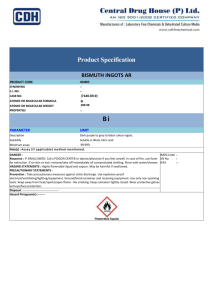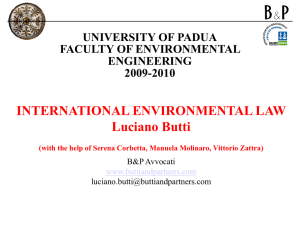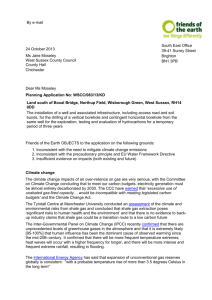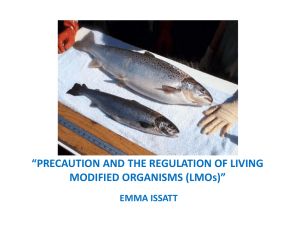this document
advertisement
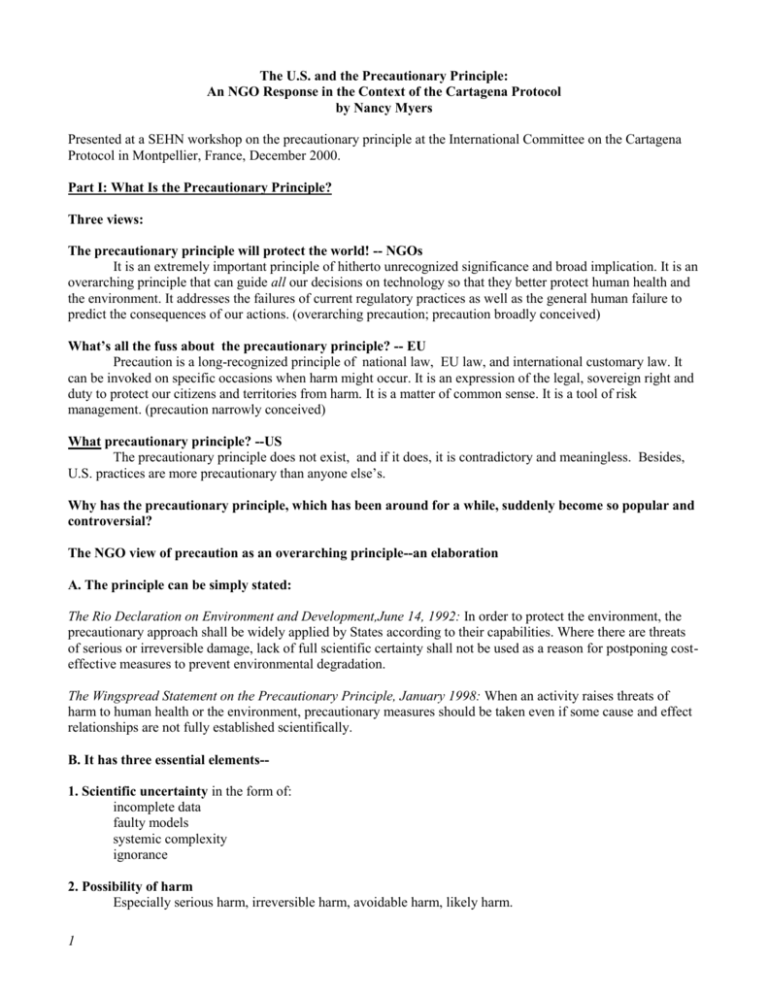
The U.S. and the Precautionary Principle: An NGO Response in the Context of the Cartagena Protocol by Nancy Myers Presented at a SEHN workshop on the precautionary principle at the International Committee on the Cartagena Protocol in Montpellier, France, December 2000. Part I: What Is the Precautionary Principle? Three views: The precautionary principle will protect the world! -- NGOs It is an extremely important principle of hitherto unrecognized significance and broad implication. It is an overarching principle that can guide all our decisions on technology so that they better protect human health and the environment. It addresses the failures of current regulatory practices as well as the general human failure to predict the consequences of our actions. (overarching precaution; precaution broadly conceived) What’s all the fuss about the precautionary principle? -- EU Precaution is a long-recognized principle of national law, EU law, and international customary law. It can be invoked on specific occasions when harm might occur. It is an expression of the legal, sovereign right and duty to protect our citizens and territories from harm. It is a matter of common sense. It is a tool of risk management. (precaution narrowly conceived) What precautionary principle? --US The precautionary principle does not exist, and if it does, it is contradictory and meaningless. Besides, U.S. practices are more precautionary than anyone else’s. Why has the precautionary principle, which has been around for a while, suddenly become so popular and controversial? The NGO view of precaution as an overarching principle--an elaboration A. The principle can be simply stated: The Rio Declaration on Environment and Development,June 14, 1992: In order to protect the environment, the precautionary approach shall be widely applied by States according to their capabilities. Where there are threats of serious or irreversible damage, lack of full scientific certainty shall not be used as a reason for postponing costeffective measures to prevent environmental degradation. The Wingspread Statement on the Precautionary Principle, January 1998: When an activity raises threats of harm to human health or the environment, precautionary measures should be taken even if some cause and effect relationships are not fully established scientifically. B. It has three essential elements-1. Scientific uncertainty in the form of: incomplete data faulty models systemic complexity ignorance 2. Possibility of harm Especially serious harm, irreversible harm, avoidable harm, likely harm. 1 A risk-free world is not possible. But we have already caused too much serious and irreversible harm, and we must be far more mindful of the consequences of our actions. 3. Precautionary action in such forms as: Monitoring, labeling, bans, phase-outs, pre-market testing Setting goals for degree of protection, reduction of hazard, quality of life, freedom from contamination, etc. that we would like to achieve Alternatives assessment Setting a precautionary research agenda (clean technologies, ecosystem principles, etc.) Additional elaborations often include-4. Burden of proof/responsibility Possibly harmful substances, practices, technologies should not be “innocent until proven guilty.” Instead, they should be “guilty until proven innocent.” Proponents of technology must be held accountable for all its effects. Precaution puts more responsibility on producers/proponents than in the past to demonstrate and maintain safety, but does not necessarily trust them to exercise it fully. Governments must hold them accountable. 5. Assessment of alternatives A habit of mind and practice as well as a form of precautionary action Asks, Do we need this? Is there a better way? How much harm can we prevent? rather than, How much harm can we tolerate? A necessary context for risk assessment. 6. Proportionality Weigh costs v. benefits, degree of possible harm v. cost of prevention, ease of precautionary action v. risk of non-action. Often placed as a limit on precaution. The precautionary principle makes room for proportionality, but is advocated as a way to give more weight to protection than we have in the past. 7. Transparency/participatory decisions For complete information (reduce uncertainty) For fairness to those who may bear more of the costs than benefits People and ecosystems cannot be guinea pigs! The precautionary principle brings science and ethics together. The comprehensive elaboration of an overarching precautionary principle has raised great hopes among NGOs around the world. Our desire for a livable world is supported by this strong, logical, science-based, socially responsible, unifying principle. The principle of precaution carries with it the added sense of the original German Vorsorgeprinzip-- “forecaring,” or thinking and planning ahead for future generations of all species. The precautionary approach is a process of acknowledging our values (ethics), examining what we know and do not know (science), and acting accordingly. It is proactive, offering all kinds of possibilities of what we can do as well as what we must not do. It is not absolute; rather, it shifts our thinking in different directions, helps us apply the full range of human intelligence to decisions about technologies. The precautionary principle, if we see it as an overarching approach, applies to all stages of thinking about how we interact with our environment--from deciding whether to have a lawn in front of our house that must be maintained with chemicals, or how many international trips we should take, to the kinds of questions our scientists should be researching with public money, or whether a chemical or a possible victim of that chemical should be given the benefit of the doubt in a court decision. 2 This is why the precautionary principle has become so popular among NGOs. This is also why it has raised fierce opposition in the US, especially among industry and the agencies of the US government that represent commercial interests. The precautionary principle challenges current ways of thinking and tools of decisionmaking. While the precautionary principle is faithful to the original intent of many U.S.efforts to protect the environment and human health, over the past 20 years that intent has been systematically subverted to economic interests. One of the key tools used in this subversion has been the sole reliance on so-called “sound science” in the form of quantitative risk assessment, and, along with it, the often inappropriate insistence on “scientific proof” of harm before action is taken. The precautionary principle, both narrowly and broadly conceived, challenges this. Part B: Responses to Nine Typical U.S. Arguments against the Precautionary Principle 1. “The precautionary principle is vague and has conflicting definitions.” SEHN response: All statements of the precautionary principle say basically the same thing: act to prevent serious harm when there is scientific uncertainty. The precautionary principle is worded differently each time it is articulated. This is not uncommon in international customary law. Although some statements of the principle are more detailed than others, there are no major conflicts among them. At the core of each statement is the idea that action should be taken to prevent harm to the environment and human health, even if scientific evidence is inconclusive. For example, the 1998 Wingspread Statement on the Precautionary Principle summarizes the principle this way: “When an activity raises threats of harm to human health or the environment, precautionary measures should be taken even if some cause and effect relationships are not fully established scientifically.” (The Wingspread Conference on the Precautionary Principle was convened in the U.S. by the Science and Environmental Health Network.) In the Cartagena Protocol, for the first time, the precautionary principle has been included in the body of an international treaty rather than only in its preamble, or as a general intention. Thus the Protocol helps to solidify the principle in international law. Broader elaborations of the precautionary approach nearly always imply three additional ideas, beyond “harm” and “scientific uncertainty”: the notion of seeking alternatives to harmful technologies; the idea of shifting to proponents of a technology the responsibility for demonstrating its safety; the goal of transparency and democracy in making decisions about technologies. Taken together, these ideas frame a broad precautionary approach which allows for a wide variety of specific precautionary actions. 2. “If precaution applied to everything, precaution would stop all technology in its tracks.” SEHN response: Many different precautionary actions can be taken. The precautionary principle allows us to say "yes" or "maybe" as well as "no" to technologies. This criticism confuses the broad precautionary approach to decision-making with specific precautionary action. It is wrong on two counts. In the first place, precautionary action does not always mean calling a halt or implementing a ban. It can also mean imposing a moratorium while further research is conducted, calling for monitoring of technologies and products already in use, adopting safer alternatives, and so forth. In the second place, a broad precautionary approach will encourage the development of better technologies. Using this approach, society will say “yes” to some technologies while it says “no” to others. 3 Making uncertainty explicit, considering alternatives, and increasing transparency and the responsibility of proponents to demonstrate safety should lead to cleaner, safer technologies. 3. “Precaution calls for zero risk, which is impossible to achieve.” SEHN response: We must cause far less irreversible harm than we have in the past. The precautionary principle points the way. While “zero risk” may be impossible, our real goal must be to impose far less risk and harm on the environment and on human health than we have in the past. The precautionary principle is based on the assumption that people have the right to know as much as possible about risks they may be accepting, in exchange for what benefits, and to make choices accordingly. With food and other products, such choices are often played out in the marketplace. A major factor in the controversy over genetically engineered food is the consumer understanding that benefits of these products (which currently accrue more to producers than to consumers) do not outweigh the risk of harm to themselves or the environment. A key to making those choices is transparency--about what products contain, and about the testing and monitoring of those ingredients. Another is support, by government and industry, for the exploration of--and rigorous research on--alternatives. 4. “We don’t need a separate precautionary principle because conservative assumptions are built into quantitative risk assessments.” SEHN response: The precautionary principle is more honest than risk assessment about scientific uncertainty. Risk assessment is the prevalent tool used in the U.S. and, increasingly, in international regimes, to make and justify decisions about technologies and products. Risk assessments have produced much valuable information and underlie many sound and protective decisions. However, U.S. policy, which is formed with precautionary intentions, has relied too heavily on quantitative risk assessments. Too often, risk assessment has been used to delay precautionary action: decisionmakers wait to get enough information and then attempt to “manage” rather than prevent risks. Risk assessment is not inconsistent with the precautionary principle; however, quantitative risk assessment is only helpful at a narrow stage of the process, when the product or technology and alternatives have been well developed and tested and a great deal of information has already been gathered about them. Quantitative risk assessment is most useful in conditions of relatively high certainty, and generally only to help evaluate alternatives to damaging technologies. In the United States, it is important for regulatory agencies to demonstrate quantifiable risk, because regulatory decisions are frequently challenged in court by industry. Increasingly in recent years, U.S. courts have demanded scientific “proof” of harm in the form of quantifiable data before upholding regulatory action. It is in the interest of regulatory agencies, therefore, to minimize apparent uncertainty by using numerical--if conservative--estimates, or to ignore uncertainty by evaluating only risks that may be easily quantified. Under the precautionary principle, uncertainty is given due weight. The nature of the uncertainties about a technology can suggest such things as whether short-term testing can provide adequate answers; and if not, whether longer-term testing and monitoring can do so; and whether the benefits of the technology warrant that investment. The precautionary principle calls for the examination of a wider range of harms--including social and economic ones--than traditional risk analysis provides. It points to the need to examine not only single, linear risks but also complex interactions among multiple factors, and the broadest possible range of harmful effects. What is not consistent with the precautionary principle is the misleading certainty often implied by quantitative risk assessments--that precise numbers can be assigned to the possibility of harm, that these numbers are usually a sufficient basis for deciding whether the substance or technology is “safe,” and that lack of numbers means there is no reason to take action. The assumptions behind risk assessments--what “risks” are evaluated and how comparisons are made--are easily manipulated by those who have a stake in their outcome. 4 5. “The precautionary principle is a tool of risk management.” SEHN response: The precautionary approach is more comprehensive and forward-looking than risk management. The attempt to limit the precautionary approach often "puts the principle in its place" as a tool of risk management, rather than a comprehensive approach to preventing harm. It implies that uncertainty will eventually be resolved through more research or trial and error. Related to the above arguments, this one assumes a narrow definition (and use) of the precautionary principle--a stop or holding action when scientific evidence is uncertain. We argue that this is only one aspect of a precautionary approach, and that, on the contrary, risk assessment as it is currently practiced may be a useful--but narrow--tool of precautionary decision-making. Article one of the Cartagena Protocol specifies that the entire objective of the document is to protect biodiversity according to the precautionary approach. Therefore, precaution is the first consideration when decisions are made on biosafety, rather than a risk-management measure that is triggered late in the process by an adverse event. 6. “Precaution itself is risky: it will prevent us from adopting technologies that are actually safer.” SEHN response: The precautionary principle helps us pay appropriate attention to costs as well as benefits of technologies. The consideration of new risks versus old risks is built into the precautionary principle. Current and prospective alternatives to harmful technologies, such as genetic modification to reduce pesticide use, must be scrutinized as carefully as the technologies they replace. It does not make sense to replace one set of harms with another. Because they insist on careful scrutiny, however, environmentalists have been accused of robbing the world of valuable, beneficial technologies. It is important to remember that technologies and regulations have always brought costs and benefits. The precautionary principle is applied so that we pay appropriate attention to the costs and harms of new technologies as well as to their benefits. Society has not done this well in the past, and devastating harm has occurred. 7. “The precautionary principle is anti-science.” SEHN response: The precautionary principle calls for more and better science. The precautionary principle calls for better investigations of complex interactions over longer periods of time. The assertion that the principle is “anti-science” is based on any or all of the following faulty assumptions: Faulty assumption #1: Those who advocate precaution urge action on the basis of vague fears, regardless of whether there is scientific evidence to support their fears. Most statements of the precautionary principle say it applies when there is reason to believe serious or irreversible harm may occur. Those reasons are based on scientific evidence of various kinds: studies, observations, precedents, experience, professional judgment, and so forth. They are based on what we know about how processes work and might be affected by a technology. However, precautionary decisions also take into account what we know we do not know. We must be much more cautious than we have been in the past about moving forward in ignorance. Faulty assumption #2: Taking action in advance of full scientific proof undermines science. Scientific standards of proof are high in experimental science or for accepting or refuting a hypothesis, and well they should be. But waiting to take action before a substance or technology is proven harmful, or even until plausible causeand-effect relationships can be established, may mean allowing irreversible harm to occur. Humans and the environment become the unwitting testing grounds for these technologies. This is no longer acceptable. Faulty assumption #3: Quantitative risk assessment is more scientific than other kinds of evaluation. Quantitative risk assessment is only one evaluation method and provides only partial answers. All decisionmaking processes, even those involving quantitative risk assessment, contain assumptions that reflect values. This does not weaken the process unless those values are hidden--for example, when risk assessment is used to further trade-related agendas. A precautionary approach aims to make such values explicit. 5 8. “The precautionary principle is a cover for trade protectionism.” SEHN response: The precautionary principle makes room for cultural values. The precautionary principle was created to protect public health and the environment, not to restrict valid trade. North American and other representatives in trade talks have leveled this accusation against the European Union in response to EU action on beef containing growth hormones and on genetically modified foods and crops. However, the real issue is not protectionism but whether a nation has the sovereign right to impose standards that exceed the standards of international regimes. The recent European Commission statement on the precautionary principle and Cartagena Biosafety Protocol both assert that right. The EU is using the precautionary principle as a much-needed safety net when risk assessment cannot provide adequate and timely answers. 9. “Precautionary actions must be temporary (subjected to further research).” SEHN response: Precaution allows for reversibility. All decisions about technology, positive and negative, should be temporary--that is, open to review and revision based on new knowledge and experience. A precautionary approach allows this to happen. As uncertainty is reduced, we may say “yes” to some things to which we previously said “no, ” and vice versa. This implies that all stakeholders should have access to relevant information. But not all uncertainties can be resolved through further quantitative risk assessments. And sometimes the judicious decision will be to turn away from technologies that pose too many uncertainties and offer too few benefits. It will not always make sense to invest limited resources into continuing research into those technologies. ---------------- 6
